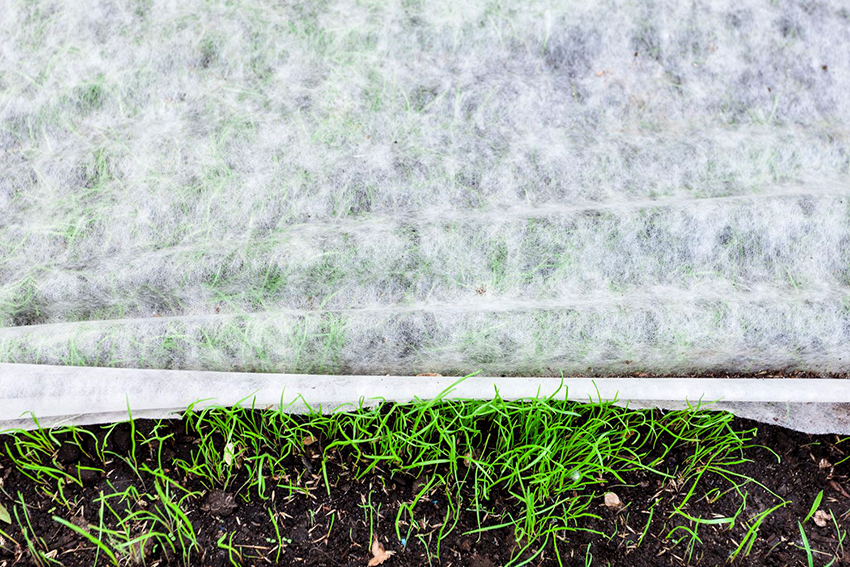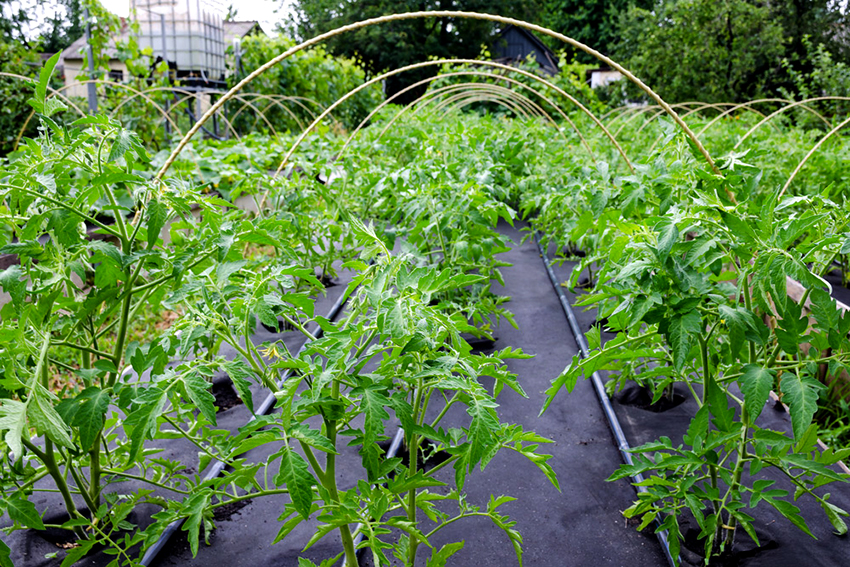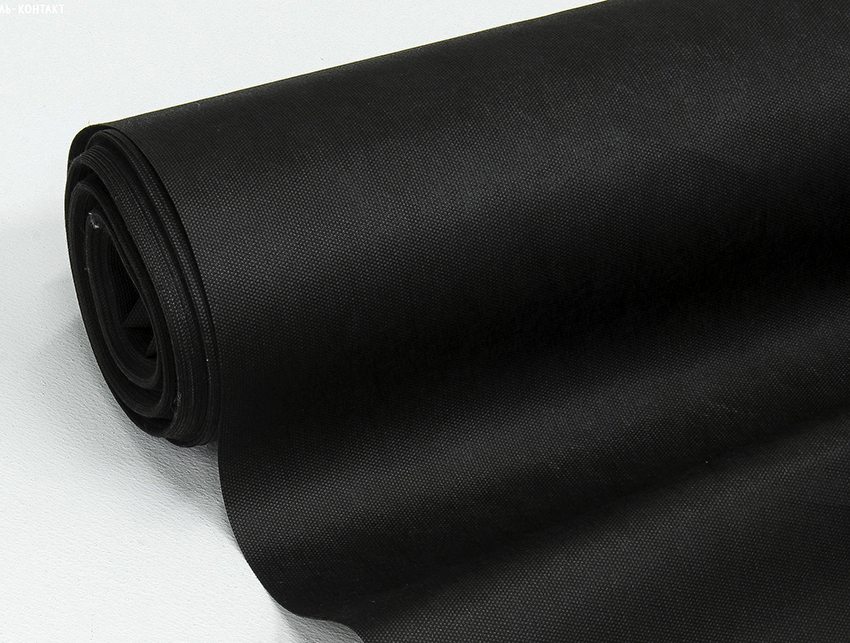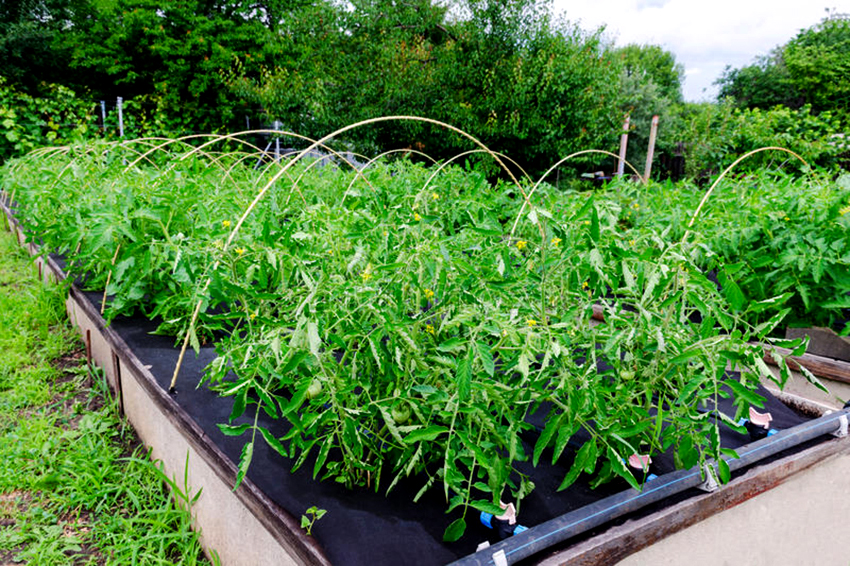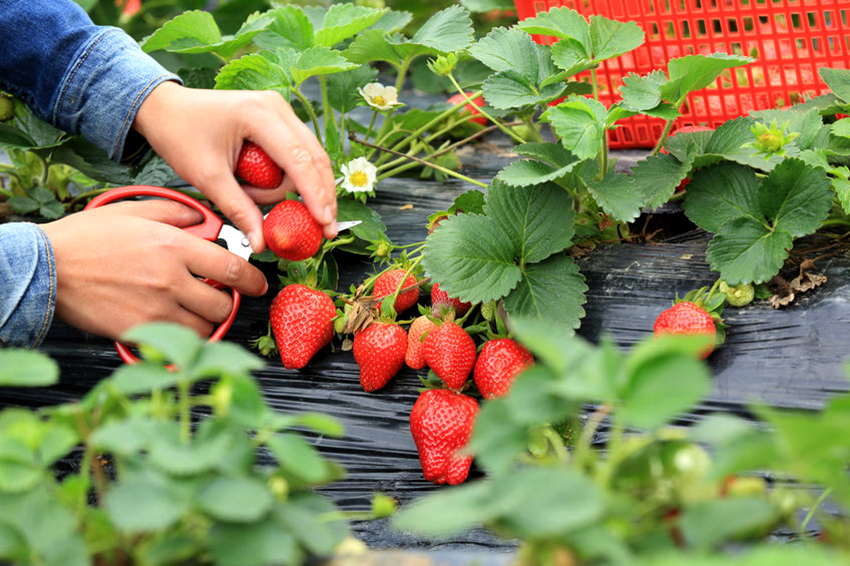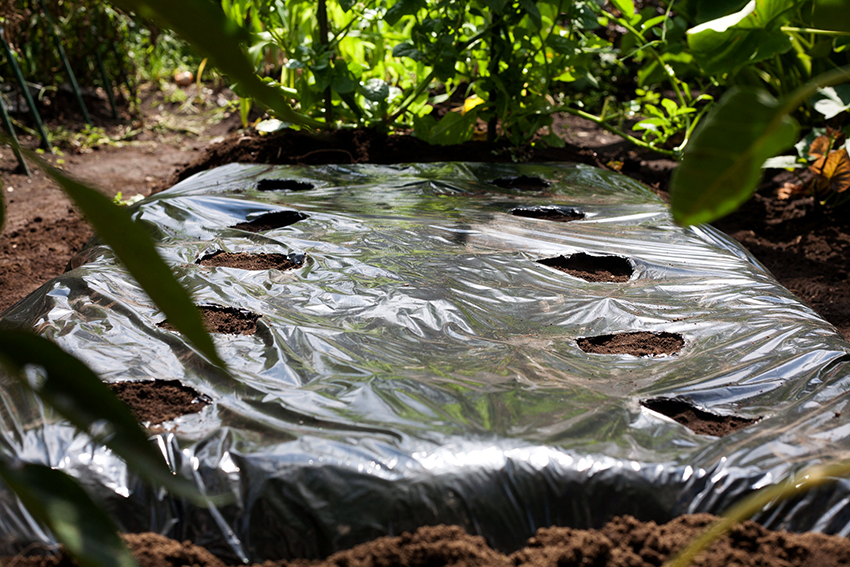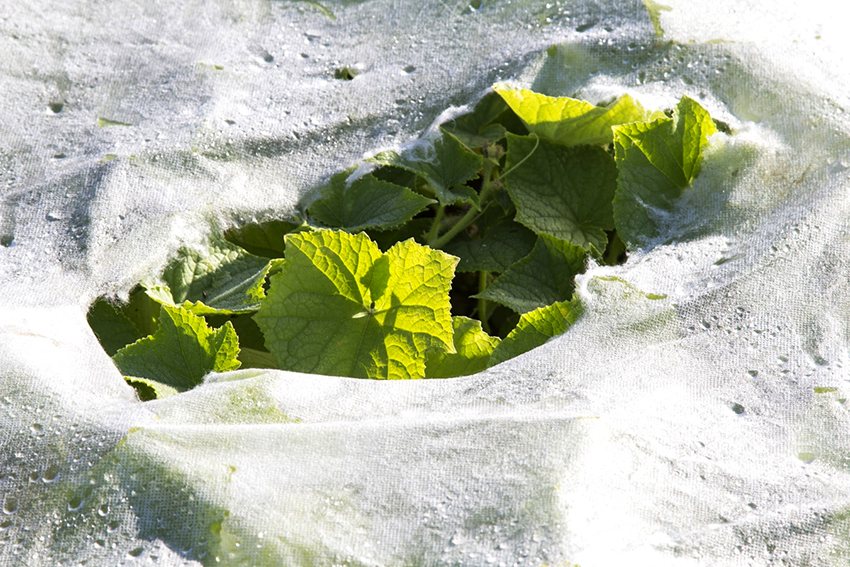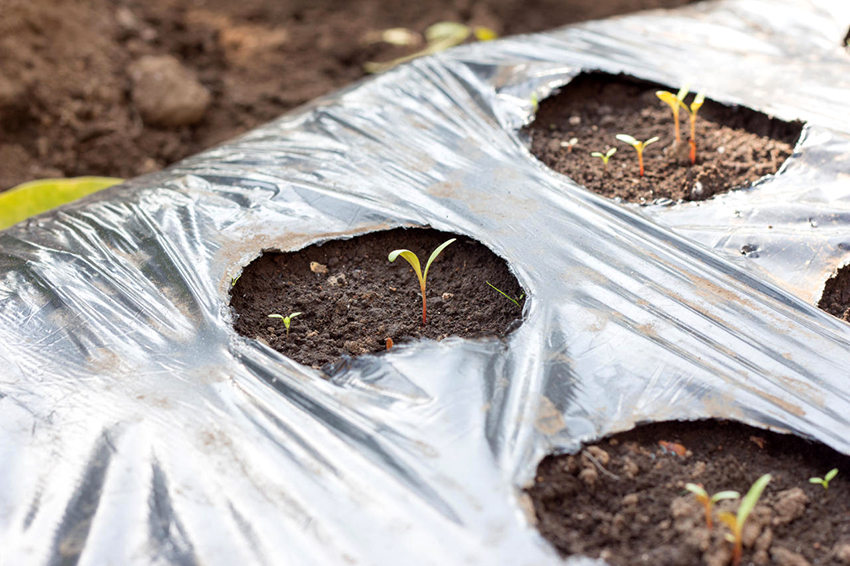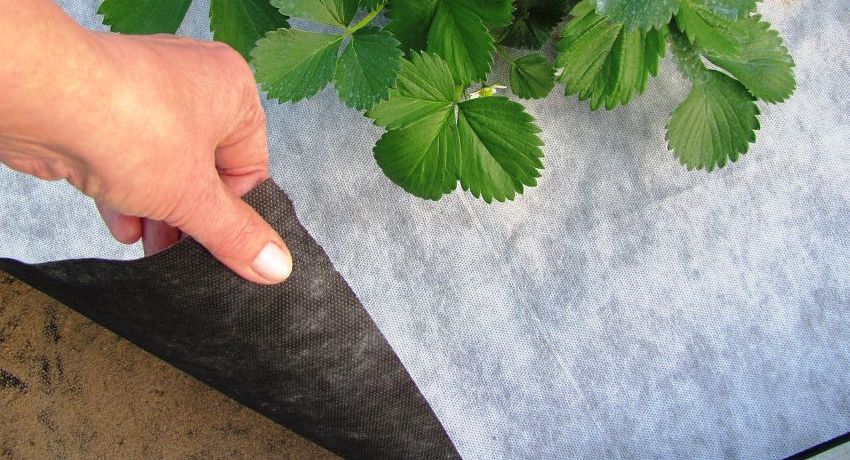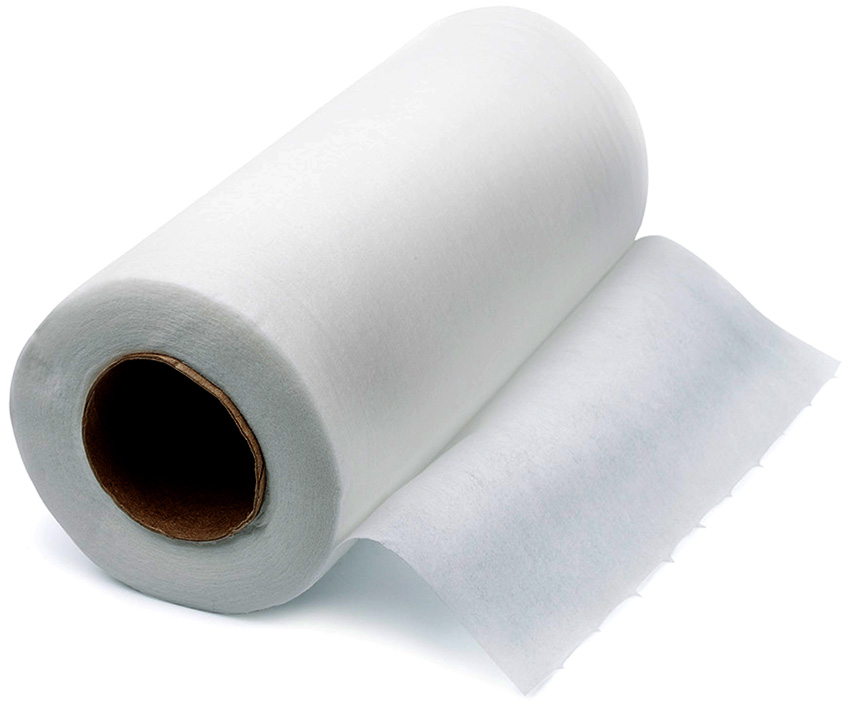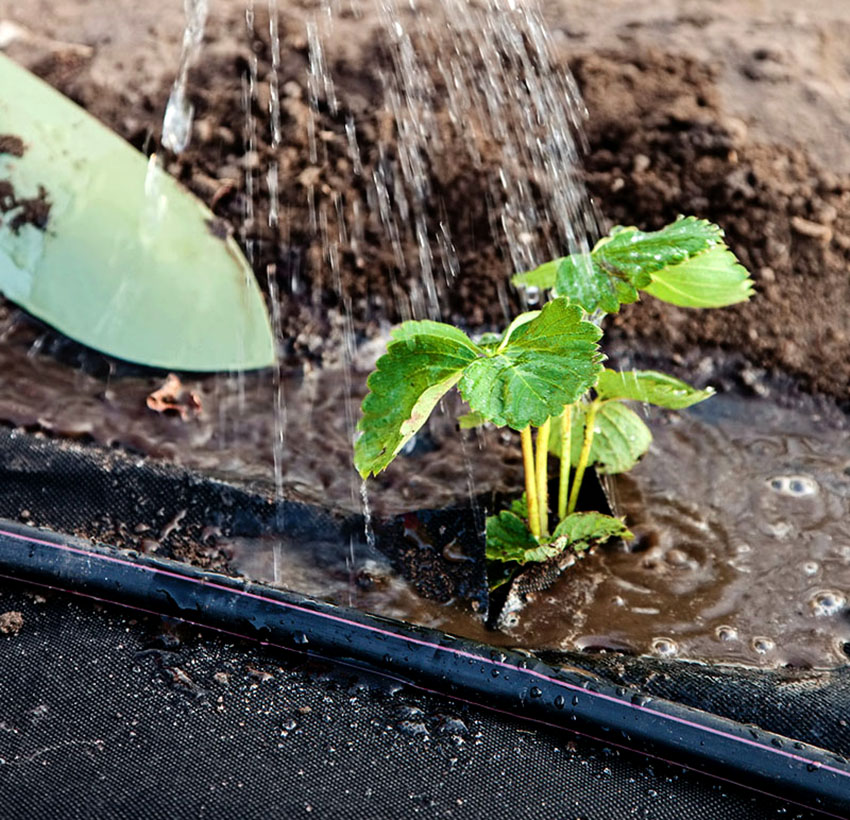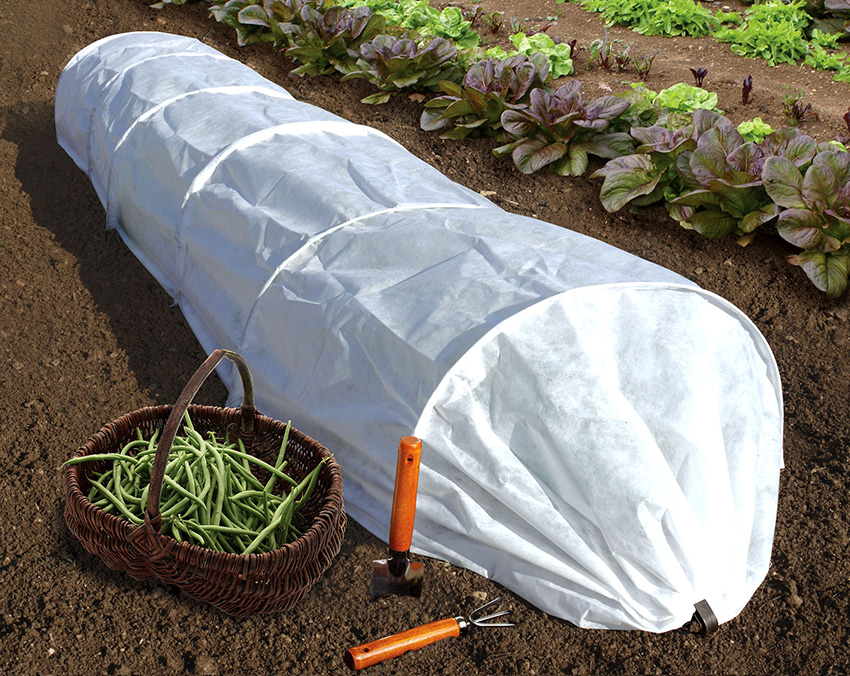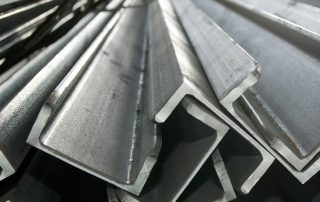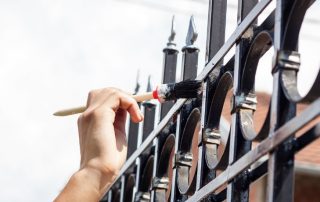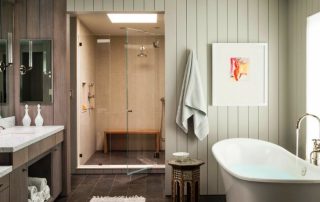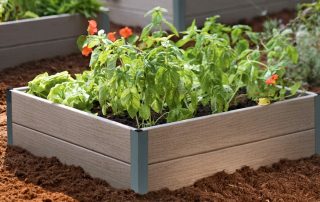Variable climatic conditions force gardeners and gardeners to take care of their plants by covering them with plastic wrap. It transmits sunlight well, maintaining an acceptable temperature for seedlings. But the covering material for polyethylene beds breaks in one season of use. Therefore, a durable substitute has appeared on the market - non-woven polypropylene fiber.
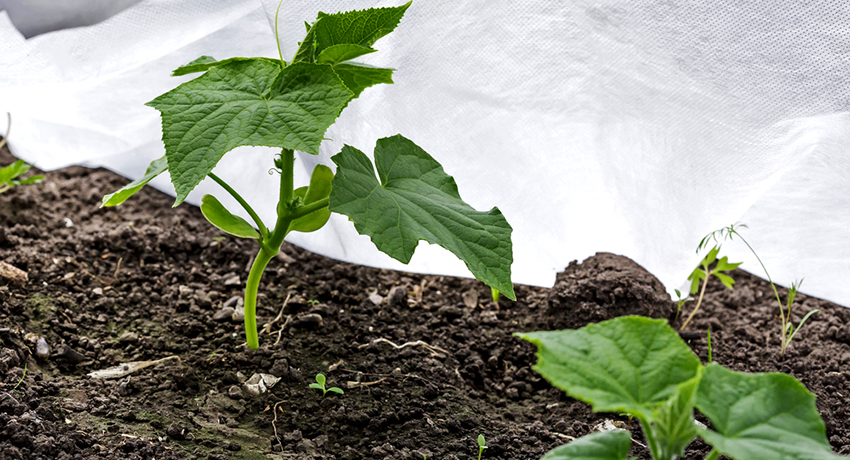
Covering material helps gardeners in caring for plants
Content
- 1 What is the name of the covering material for the beds: its types
- 2 Black covering material: the pros of using it
- 3 Covering material for strawberries and other types of berries and vegetables
- 4 How to grow cucumbers under the covering material
- 5 Recommendations: how to choose a covering material for beds
- 6 How to cover the beds with covering material: rules and recommendations
What is the name of the covering material for the beds: its types
Plant protection materials are most often referred to as spunbond, agrotextile and agrofibre. From a technical point of view, these are different names for the same covering product. In practice, only the specific gravity and color of the materials, their ability to trap ultraviolet light and pass water through, matter. Geotextiles occupy a special place among such products. It has a higher density than the other analog of the covering fabric. The use of geotextiles by gardeners is limited to the creation of a substrate for the grown plants. In this way, an effective weed control is carried out.
The average shelf life of agrofibre is 6-7 years, and geotextiles (as a more durable analog) serve even longer. Such a long period of operation makes it economically feasible to purchase covering materials as opposed to rapidly tearing polyethylene.
Covering material for beds: varieties and purpose
There are three main functional types of these "blankets" intended for growing plants in the garden:
- black dense nonwovens, as well as garden geotextiles - they are used to control weeds;
- medium-density varieties of white spunbond and its analogues, which cover plants in cold periods of the year;
- light white covering materials that protect crops from frost in spring and from excessive heat in summer.
For certain types of garden crops, agricultural fabrics are produced in gray and green colors. Regardless of the density, these materials do not require the construction of a frame when laid on the ground.Black weed film is used to mulch the earth, white agrofibre to reflect the visible part of the sunlight spectrum and to absorb infrared rays. Regardless of the color, all types of covering materials are designed to freely pass moisture to the roots of plants, and air to their leaves.
A special type of agrofibre is designed to create shading nets. With their help, plants are not allowed to wither under a powerful stream of solar ultraviolet radiation. Such a mesh is stretched over a lightweight frame in the form of a domed structure. In addition, it protects the crop from the encroachment of birds.
Black covering material: the pros of using it
Weed grass on a land plot brings tangible harm. The most effective way to control weeds is to remove them by hand, but this is physically difficult. In addition, certain types of weeds reproduce by growing parts of rhizomes and shoots remaining in the ground. Therefore, weeding must be carried out several times during the season.
To help gardeners, manufacturers have developed and put on sale a special covering black material. It freely lets in atmospheric precipitation and air, but completely blocks the sun's rays. No weeds can survive in such conditions.
This material is often referred to as black spunbond, which is not entirely accurate. Spunbond is both the name of the trade mark and the name of a special technology for the manufacture of nonwoven fabric. Covering materials from such companies as Agrotex, Lutrasil, Agrospan, Lumiteks, Agril and others are widely represented on the Russian market.
It is very important to use agrofibre correctly:
- wait until the soil dries up after the winter period;
- use any sharp or cutting object to make cuts in places where plants are planned to be planted;
- spread black material over the entire area of the beds.
Such agrofibre is called mulching. The benefits of its use are that there is no need for weeding, as well as earlier ripening of vegetables and berries. In particular, a bed of strawberries under a black cover material can yield two weeks earlier than usual. The advantage is that ripe berries do not come into contact with the ground, which means they are less dirty. Thus, water consumption for cleaning the crop before selling it is reduced.
Relatively recently, they began to use black and white covering materials. This know-how looks like this: the black side of the canvas is laid on the ground, the white color remains on top. Its surface reflects the sun's rays well on the plants growing in the slots, which has a beneficial effect on their growth.
Covering material for strawberries and other types of berries and vegetables
Polypropylene protective coatings were initially used for greenhouses using a frame base. But it soon turned out: if you reduce the specific gravity of such a material, it can be successfully used in the beds. For example, for strawberries, the density of polypropylene fibers should be between 17 and 30 g / cm³ of surface. The coating used on this berry is excellent for growing raspberries, cucumbers, potatoes and peppers. The lightest materials (with a density of 17 g / cm³) cover early greens: dill, parsley, onions and basil.
Strawberries feel great under the cover material. The absence of problems in caring for plants makes it possible to several times reduce the labor costs of gardeners for growing this crop.
As a result of using this type of material, we get a number of advantages: the yield of strawberries grows significantly, berries ripen under cover faster, and the beds are not afraid of frost.In addition, during dry periods, moisture loss is reduced - therefore, water used for irrigation is saved. It becomes virtually impossible for birds and harmful insects to reach the crop.
Useful advice! The prices of covering material for beds from different manufacturers do not differ too much. Pay attention not so much to the cost and brand as to the density of the polypropylene.
With a relatively modest financial investment, you can equip a drip irrigation system for a strawberry garden. It will pay for itself over several years by saving water and energy. At the same time, it will eliminate the difficulties of watering the berry culture through the holes in the substrate. Plant roots will never dry out, giving sustainable seedlings and bountiful harvests.
Planting strawberries on black covering material can be carried out in spring and autumn. It is recommended to grow this crop in one garden bed for three to four consecutive years. Agricultural experts emphasize that when young seedlings are used for planting, their yield will increase every year, regardless of the selected strawberry variety.
How to grow cucumbers under the covering material
This garden crop grows well in warm conditions with sufficient, but not too much, sunlight. It is difficult to grow a good harvest of cucumbers. In early spring, these plants can die from frost. In summer they suffer from extreme heat and lack of moisture. There are also many types of insects and microorganisms that can harm cucumbers.
Useful advice! If a lot of pests appear on the site: vole mice, ants, slugs - it is allowed to lay mulching agrofibre in two layers. Before you start spreading the canvas, it is advisable to lightly sprinkle the beds with finely ground black pepper.
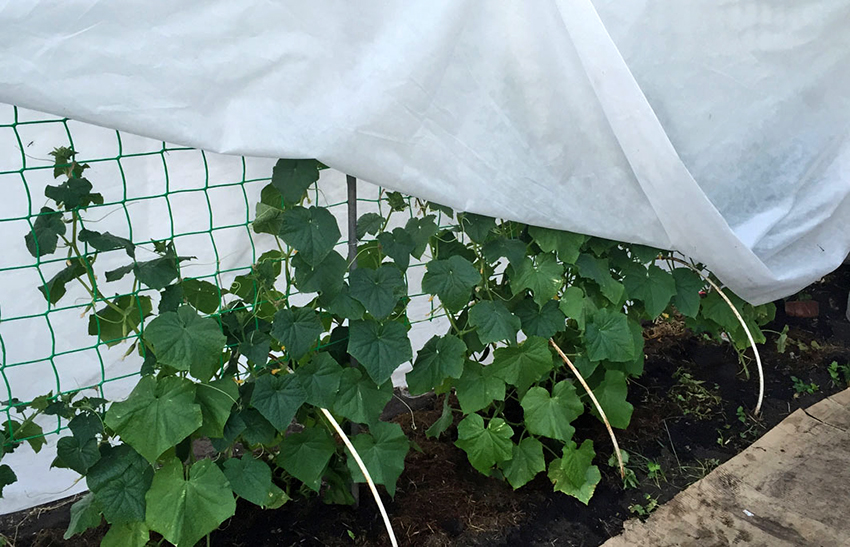
To cover the cucumbers from above, it is recommended to use PVC film, polyethylene or white spunbond
Appropriate protective materials will help to solve all the listed problems. For shelter from above, use ordinary or bubbled polyethylene, as well as PVC film. There are reinforced options for such canvases - to give them greater strength. As a top cover for cucumbers, you can use white spunbond or its analogue of low density - about 28 g / m² (the same density is also suitable for tomatoes).
The advantage of the latter option is the ability to water the seedlings from above. The liquid will seep directly through the fibers of the material. In addition, agrofibre traps ultraviolet rays, redirecting only the soft part of the sunlight spectrum to the cucumber seedlings.
The best option for laying the ground in the garden is non-woven agrofiber. This black weed cover material has several advantages. It is easy to make holes in it. Through them, plants are watered and fertilized (as a rule, with decayed foliage, compost or manure). At the same time, moisture practically does not evaporate from the soil, which means that watering cucumbers can be carried out much less often. The access of insect pests to plant roots will be significantly hampered.
Useful advice! Planting cucumber seeds should be carried out in moist and warm ground. Plants are planted at a distance of 50 cm from each other. With this in mind, it is necessary to make holes in the agrofibre spread on the ground.
The optimum temperature for growing cucumbers is 20 ° C during the day and a few degrees lower at night. The use of covering materials allows you to maintain the required temperature directly in the open air, without placing plants in greenhouses.
When using agrofibre, it is enough to moisten cucumbers only twice a week (after planting in mid-spring). The best way to fertilize is by sprinkling with sodium humate dissolved in clean water. Concentration - one spoonful of ingredient per bucket.
Recommendations: how to choose a covering material for beds
If you need to find the cheapest material to protect plants from adverse conditions, then polyethylene will do. It is transparent, lets the sun's rays through from the outside, and keeps the heat accumulated above the soil inside.
Polyethylene also has some disadvantages:
- the material must be pulled over the arc frame;
- in direct contact with plants, polyethylene can physically damage them;
- during watering of the beds, the frame will have to be removed, because this canvas does not allow water to pass through;
- in summer, the material is inapplicable, since it prevents the penetration of air, which will destroy the seedlings in the heat;
- the condensate formed under the film is a favorable environment for the reproduction of pathogenic bacteria;
- the structure will have to be periodically patched up, because the wind will tear it, especially at the bends of the arcs.
Related article:
Spunbond: what it is, material possibilities and efficiency of use
Scope of application. Manufacturing material and varieties. Prices and manufacturers. Features of use and optimal storage conditions.
If you need to get rid of the listed problems, spunbond is the best solution along with analogues of covering materials from other manufacturers. The production of agrofibre is as follows. The polymer is melted and passed through dies. Many long, thin threads are formed. They are held together with a special compound and cooled. The output is a thin but strong film with a cellular structure. It is soft to the touch and has a low specific gravity.
You can often find white spunbond in the photo, and of a low density. They can cover many types of garden plants, including tomatoes and peppers.
Useful advice! It is recommended to measure the area of the beds in advance and purchase one piece of agrofibre of the required area. Sewing together individual fragments of this material by hand will not give the protective effects that its integral structure has.
For mulching, select black covering material for beds with a density of 60 g / cm³ and higher. However, for the northern regions of Russia, it is better to use a white canvas, as it accumulates heat well underneath. For the southern regions of the Russian Federation, a black and white material is recommended that repels part of the sun's rays. Otherwise, it is black.
You can also find green agrofibre on sale. But it is mainly used for gardening work, as well as for cases when it is necessary to create the illusion of a grassy lawn for viewing from medium to long distances. For the Far North, where there is little sunlight, it is advisable to purchase foil-clad agrofibre: it reflects light radiation better on plants.
How to cover the beds with covering material: rules and recommendations
An important parameter of agrofibre for mulching, which you should pay attention to when buying, is the roll width. It varies in the range of 1.5-3.2 m. A width is selected that will be enough to cover a garden bed with a ten-centimeter margin on both edges. After spreading the material to the ground, these protrusions are sprinkled with earth. This completes the styling process. The width of the bed depends on the type of plant being grown. For example, for a strawberry bed with a covering material, a roll of 3.2 m wide will be required.
Before laying agrofibre, small square, round or cross-shaped cuts should be made in it. The intervals between such holes should correspond to the distance at which the plants are supposed to be planted. The upper cover of a berry or vegetable crop with a material of low density can be done without any additional fasteners.
How to fix the covering material on the garden bed? It is enough just to lay the spunbond on the surface and hammer the pegs along its edges so as not to be blown away by the wind. You can build a mini-greenhouse from dense agrofibre by pulling the material onto a previously prepared frame.
This design can be opened on one side for ventilation and ease of watering. Frame shapes are either arched or rectangular.
Which side to cover the beds with covering material
There is no fundamental problem in this matter in the case of plastic wrap. It is the same on both sides. Covering material such as agrofibre should be laid with the top side up, the bottom side down. Some difficulties arise only in terms of how to distinguish one side from the other on a roll. Visually, they are very similar. This must be done by touch. Smooth surface - lower, rougher - upper.
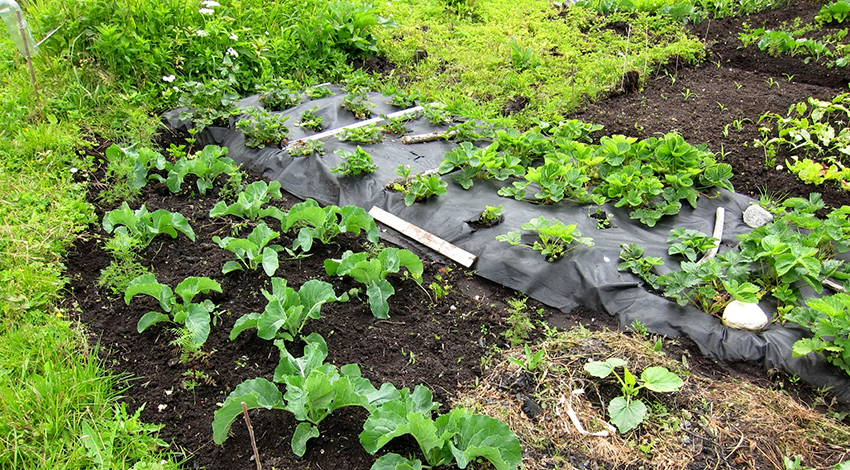
If the fiber is monochromatic, then it should be laid with the rough side down, and the smooth side up.
If the material is black and white, the black side is definitely the bottom. It must absorb heat, preventing weeds from growing.
How to use the covering material for the beds
Any type of agrofibre is designed in such a way that the gardener pays as little attention as possible to the material itself after laying it. It is necessary that he cares exclusively for his seedlings. Problems with the operation of non-woven polypropylene coating can arise only if it has been blown away by the wind (usually due to poor adhesion).
In areas with strong winds, the use of reinforced agrofibre is recommended. Inside, such a material is equipped with a rigid mesh, which allows it to be firmly fixed to the frame, for example, using a wire. Covering material for weed beds can not be touched after installation for several years. Especially when it comes to planting perennial plants in a garden bed. Agrofibre will be good at letting water through and retaining sunlight until holes appear on it from wear.
Nonwovens in the garden have another use. With their help, you can equip paths along the beds. On the one hand, additional weed protection is obtained. On the other hand, the base of such a track will absorb water well, which will prevent the structure from deforming. In its lower layer there is crushed stone, above it is geotextile, then there is a layer of sand. At the very top there is a tile or stone cladding.
As you can see from the above, there is no problem in choosing which covering material for the beds. It is only necessary to take into account the climatic zone in which the vegetable garden is located, the size of the beds, the type and variety of plants grown, as well as the season planned for farming. Taking into account the above factors, you can get a guaranteed increase in yield from each hundred square meters of land with a simultaneous reduction in labor costs.
